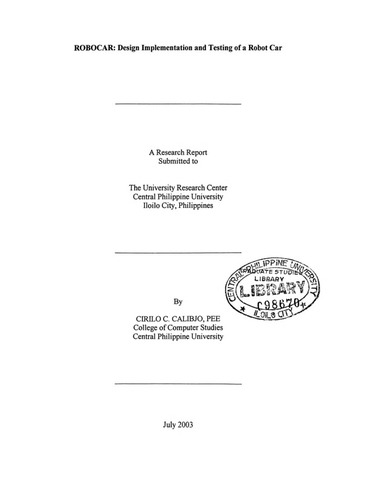Robocar: Design implementation and testing of a robot car
| dc.contributor.author | Calibjo, Cirilo C. | |
| dc.date.accessioned | 2021-05-31T06:52:40Z | |
| dc.date.available | 2021-05-31T06:52:40Z | |
| dc.date.issued | 2003-07 | |
| dc.identifier.citation | Calibjo, C. C. (2003). Robocar: Design Implementation and testing of a robot car (Research report). Jaro, Iloilo City: University Research Center, Central Philippine University. | en_US |
| dc.identifier.uri | https://hdl.handle.net/20.500.12852/934 | |
| dc.description | Abstract only | en_US |
| dc.description.abstract | This study was conducted to design, construct and test the performance of a Robot Car. Specifically, the study aims to develop a working prototype of a microcontroller driven LEGO car; develop step-by-step instructions for building a Robot Car; test the performance of the Robot Car using a circuitous track made of black electrical tape; determine the average illumination levels for the photo resistors to react either to stop or steer the car; and to measure the effective distance for the infrared sensor to give appropriate signal for a possible obstacle in the path. The “Robot Car” used embedded control in the form of a micro-controller board and was designed to follow a path made of black electrical tape on a white background. The track was a circuitous course that contains 3-inch long strips of electrical tape perpendicular to the main track. These strips are long enough to overlap all three sensors on the line-tracker. Results revealed that if an obstacle, about eight (8) inches far, is encountered the vehicle stops until that path is once again clear. The photo resistors allowed the car to be steered by a flashlight ort to stop when ambient light decreases to approximately 5 lux. The development of a prototype ROBOCAR will allow students in the course, Embedded Computer System Design, to design, build, and debug their own robot that will play in a competitive performance event. The hardware, software, and other information they need to design, build, and debug their own robot are provided by this study. This will enhance students’ interest about robotic design and other applications that are revealed to various Software Engineering classes. | en_US |
| dc.format.extent | v, 89 leaves | en_US |
| dc.language.iso | en | en_US |
| dc.publisher | Central Philippine University | en_US |
| dc.subject.ddc | GSL 004.72 C128 | en_US |
| dc.subject.lcsh | Automated vehicles | en_US |
| dc.subject.lcsh | Robots--Control systems | en_US |
| dc.subject.lcsh | Robots--Design and construction | en_US |
| dc.subject.lcsh | Robotics | en_US |
| dc.title | Robocar: Design implementation and testing of a robot car | en_US |
| dc.type | Technical Report | en_US |
| dcterms.accessRights | Limited public access | en_US |
| dc.description.bibliographicalreferences | Includes bibliographical references | en_US |
| local.relation.associatedcontent | https://repository.cpu.edu.ph/handle/20.500.12852/706 Full paper published in Patubas | en_US |
이 항목의 파일
This item appears in the following Collection(s)
-
Research reports [167]
-
Research reports [2]


